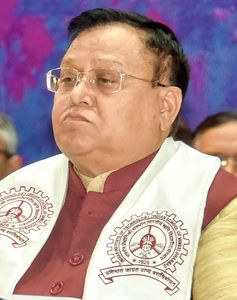Interview/ V.K. Saraswat, Member, NITI Aayog and the advisory committee of India Semiconductor Mission
A FORMER SECRETARY of the Defence Research and Development Organisation, Vijay Kumar Saraswat has played a pivotal role in developing indigenous missile systems such as Prithvi, Dhanush, Prahaar and Agni-5, as well as India’s ballistic missile defence system, the fighter jet Tejas, and the nuclear submarine INS Arihant.
He also launched the Photonics Valley Corporation in Telangana to advance silicon photonics, crucial for 5G and supercomputing, and has led India’s microprocessor development for smart cities and internet of things. In an exclusive interview with THE WEEK, Saraswat, 75, speaks about the past, present and future of the Indian semiconductor sector. Excerpts:
Q/ For long, unclear trade policies, high import tariffs, an unfavourable tax regime, limited domestic demand and overall governmental inaction ensured that we do not have any commercial semiconductor fabs. How does the Narendra Modi government plan to change this?
A/ The entire commercial electronics sector in India is assembly-based. We import television kits, assemble them here, and sell them. The same applies to most electronic products. So, semiconductor imports―chips, integrated circuits, devices―were largely limited to critical sectors and did not penetrate the commercial sector. The government found it difficult to invest when demand was so low. But it was a catch-22 situation. We believed that the availability of semiconductors in the country would spur demand. That is why, in 2014, the government of India decided to make upfront investments and involve the private sector in manufacturing to compete with global technologies.
Q/ Despite being greenlit, several semiconductor fab projects―including those by the JP Group and Tower Semiconductor―did not materialise during Modi’s first term. Will projects based by the India Semiconductor Mission meet the same fate?
A/ The licences for these companies were issued during the previous (UPA) government’s time, and around 2015, I also got involved. We discovered that the policy had major drawbacks. For example, while the government promised support, it required private companies to first invest and successfully demonstrate semiconductor production before reimbursement. That meant private players had to take the initial risk in an ecosystem where demand and market size were uncertain.
I worked with them for three years, tried to persuade them, and assured them that we would help create a market. But the requirement of upfront investment made the proposition too risky, so they withdrew their licences.
Some of these companies also lacked financial muscle. They hoped for support from international financial institutions. But with unclear demand and limited capital, banks and institutions hesitated. Although they signed contracts with companies from France and Taiwan for technology transfer, they failed to secure the financial inputs needed.
In 2017, we decided that the government must absorb the initial investment risk. Today’s policy ecosystem is far more supportive―and that is why so many companies have now come forward.
Q/ Current estimates suggest that Indian semiconductor facilities will not be producing chips smaller than 20 nanometre anytime soon, while global players are already making sub-10nm chips. How long could it take for India to catch up?
A/ We should not follow the same trajectory as others. Our market research shows that 70–80 per cent of the products we manufacture―both strategic and commercial―can be supported by 28nm technology. Our focus is currently on 28nm and above. We are also looking at 65nm and 90nm, as analog and memory devices can be made with these
mature technologies.
Q/ From a national security standpoint, how essential is India’s push to become a semiconductor powerhouse, especially with the government’s ‘Make in India’ push in defence manufacturing? How soon might we see indigenous chips powering India’s defence sector?
A/ This is a very important point. Everything is digital today. Not only in strategic sectors like defence, but even in commercial sectors, vulnerabilities are high if we rely on imported chips and technologies. Cyber warfare is the next frontier, and we expose ourselves if our digital infrastructure is based on foreign products.
That is why the government has prioritised domestic chip manufacturing. The 28nm node will cater significantly to the defence sector. The upgraded Semiconductor Laboratory in Mohali, which will soon support 90nm and 65nm, will start churning out many devices that meet national security needs. Facilities in Gujarat and Assam will focus on 28nm chip packaging. Domestic packaging gives us access to design verification and quality checks―ensuring no bugs are embedded in imported products. Even with just ATMP (assembly, testing, marking and packaging), we improve our sense of security.
Q/ India has signed an agreement with the US to establish a semiconductor fabrication plant for national security purposes. Can we expect similar government-to-government partnerships with other nations?
A/ These are strategic decisions based on our partnerships. With China dominating the semiconductor market, the US has realised it must strengthen its own capabilities. Many US foundries, including IBM, moved operations to China. That is why the US made a major investment of $22 billion to set up new foundries there.
Given our current relationship with the US, the joint fab is one of the most potent collaborations. They are investing, and we also need special foundries for strategic sectors. Similar partnerships are possible, but only with countries willing to invest and contribute―not those relying on others for their needs.
Q/ What will be India’s role in the chip war between the US and China?
A/ India has hardly any major role to play in the chip war. But if we come up with our own technology, facilities and production capacity at the earliest, we can compliment the efforts of the US in a big way by providing them low-cost chip manufacturing―reducing their dependence on China. So, to that extent, India can play a role. Everyone says ‘China plus one’; that ‘one’ should be India, making headway to the US market.
Also Read
- Huge ‘Atmanirbhar Bharat’ move! India greenlights four new semiconductor plants
- Chip giants meet: What is brewing between Nvidia CEO Jensen Huang and TSMC CEO C.C. Wei?
- India to get sixth major semiconductor plant; HCL-Foxconn unit to add 2,000 jobs
- Will India's ambitious plan to build a semiconductor ecosystem succeed?
- Why no country can be 'aatmanirbhar' in semiconductor sector
- India is making strides, but reliance on imports will not diminish overnight
Q/ So far, five semiconductor plants have been sanctioned under ISM. Four are in Gujarat and one in Assam―both the states are governed by the BJP. Is there a political agenda behind the location choices? How is the government ensuring equitable distribution?
A/ Plant locations are selected based on the ecosystem available in each state. Private investors assess factors like financial incentives, infrastructure, logistics, and, to some extent, availability of skilled manpower. Water, power and a good chemical industry are essential. Gujarat and Assam offered those advantages.
Other states also submitted proposals, and the private sector chose where to invest. I don’t think politics played a role. For instance, there was a strong push for Karnataka, but water scarcity and industrial congestion may have deterred investors.
As for Assam, the goal is to promote the northeast. The state has no water or power problems. The only challenge was manpower, and the Assam government is training 3,000 young people through NASSCOM and other agencies. It is a major initiative that the state has taken. Costs are also lower.



